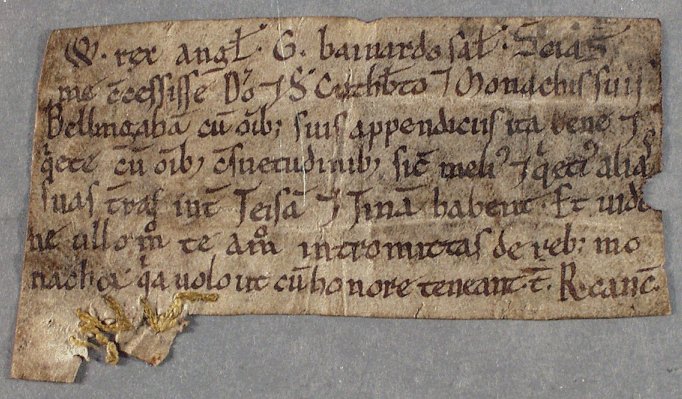Writ of William II concerning Billingham, [c.1090] (DCD 1.1.Reg.7; Scriptores tres App. p. xx. Regesta i, no. 344)
DCD 1.1.Reg.7.

Ed., with facsimile, Bishop & Chaplais pl. VIIa.
Writ of King W[illiam II] for the monks of Durham.
Undated, but see below.
This tiny document has a strong claim to be regarded as the oldest in the monastic archive. It is a fine example of the extreme terseness and economy with which the Norman kings, and their chanceries, expressed their wishes in such documents, of which the originals are normally landscape format. The king greets G[eoffrey] Bainard who is to know that the king has conceded to God and St Cuthbert and his Monks Billingham, to be held by them quite as well and quietly (`melius et quietius’) as they have their other lands between Tyne and Tees [one of the standard ways of identifying County Durham during the medieval period]. Geoffrey is to see that he does not in any way henceforth interefere with the monks’ things (`Et uide ne ullo modo te amodo intromittas de rebus monachorum quia uolo ut cum honore teneant. teste R. cancellario.’) [view].
The witness, R[obert] Bloet, was succeeded as chancellor by William Giffard by 19 March 1094. As the writ is not addressed to the bishop of Durham Bishop and Chaplais concluded that it must date from the period of his exile, 1089-1091, and perhaps in the late summer of 1091 when William was in the North. Their conclusions about its script suggest that it was likely to have been written locally.
Bishop and Chaplais identified the scribe of this document with that of four other documents in the monastic archive, see 2.1.Reg.17 (genuine), 2.1.Reg.11, 2.1.Reg.14, 3.1.Reg.6 below, of which one is a genuine writ of King Henry I and the other three forgeries.
The seal was evidently attached in the normal fashion for a writ, on a tongue cut horizontally along the foot from the left-hand end, as would be natural for a right-handed knife-wielder. With writs initially conceived of as documents of ephemeral significance, as against charters, the fact that the seal was liable to tear away was not perceived as a serious design-fault; when this happened here the tongue was sewn to the body of the document.
